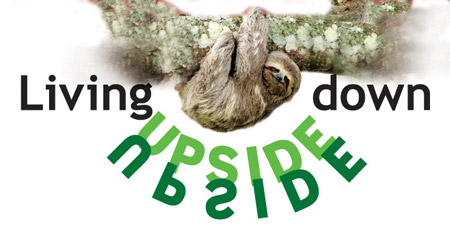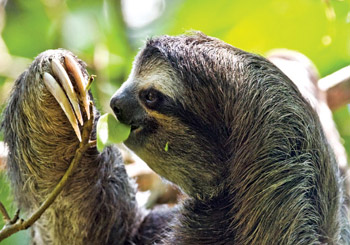|
Sloths:

How do you think it would be like to spend your whole life upside
down having a bird's eye view of this world? Exciting? Then all you need
to do is exchange places with one of the most laziest and slow moving
group of animals on this Planet Earth - the sloths.
Residents of the rainforests of Central and South America, sloths are
medium sized mammals that belong to the families Megalonychidae and
Bradypodae, which
 are
a part of the order, Pilosa. The name sloth comes from the mid-English 'slowthe'
meaning slow. are
a part of the order, Pilosa. The name sloth comes from the mid-English 'slowthe'
meaning slow.
These mammalians spend their entire lives hanging upside down from
tree limbs in the rainforests. In fact, they eat, sleep and even give
birth to their young, hanging upside down. Amazing isn't it?
Moving only when necessary and that too very slowly, sloths are said
to be slower than even the snails, when it comes to movement; on the
ground, their maximum speed is 1.9 k per hour (1.2 mph).
If you are wondering as to whether they ever come down to the ground,
the answer is, they do, but just once a week to answer a call of nature;
urinate and defecate.
According to researchers, sloths are similar to cats in their toilet
habits. They have been observed digging holes in the ground for this
purpose and then covering them once they've finished, just like cats do.
They are also known to use the same spot each time they need to answer a
call of nature.
Even though coming down to the ground makes them vulnerable to
predators (easy catch for animals that hunt them) researchers have no
clue as to why they take such a risk.
Some researchers believe that this could be to avoid making any
sounds that would attract attention to themselves because these animals
have been observed to relieve themselves while hanging on to tree limbs
only during storms, in the rainy season when there's plenty of noise
around.

Many others think this risk is taken to attract a mate because sloths
spend most of their time up on the trees, virtually in one place and are
hardly visible.
But as sloths have a far more acute sense of smell than vision,
burying their excreta near the trunk of the trees they live in, not only
nourishes the trees but also signals of their presence to a possible
mate.
Even though hunting has contributed greatly to the decrease in the
sloth population and perhaps even to the extinction of one species,
today there are six living species of sloths with just one species, the
Maned Three - Toed sloth (Bradypus torquatus) being classified as
'endangered.' Since sloths are not capable of surviving outside the
tropical rainforests of South and Central America, the ongoing
destruction of these forests may have a strong impact on the survival of
these animals.
Sloths are sturdy animals and have physical attributes that are well
adapted to their lifestyles.
They have short snouts, flat heads, big eyes tiny ears, stubby tails
of about 6-7cm long, strong claws and long legs.
Their fur is generally greyish brown in colour and the outer hairs
grow in an opposite direction to that of other mammals. In most mammals,
the hair grows towards the extremities, but in sloths they grow away
from the extremities because sloths spend much of their time hanging on
tree limbs, with their legs above their bodies. This protects the
animals from the elements. Their bodies are between 50 to 60 cm long.
As we explained earlier, the fur is generally greyish brown in colour,
but at times their coats appear to be grey-green in colour. There is a
reason for this. Since they are extremely slow moving animals,
camouflaging algae grow all over their coats.
In fact, their coats hosts many species of 'non-parasitic' insects
and are a 'small ecosystem' of their own.
Since they spend most of their lives hanging upside down from
branches of trees, they have specialised hands and feet; long, curved
and strong claws that provide a good grip when hanging onto branches.
It is said that because of these strong claws, sloths remain, hanging
from trees, even after death. Even when they are shot, they rarely fall
down.
Their claws are their only natural defence when they are cornered by
a predator, when they come down to the grounds. Their main predators are
the jaguar, harpy eagle and humans.
Since they have quarter as much muscle tissue as other animals of
similar weight, they burn large amounts of energy when they try to move
at speeds of 15 feet per minute, to escape from predators.
Sloths are basically herbivorous animals (their taxonomic names mean
leaf eaters) and their diet is mostly leaves but it may also comprise
insects, small reptiles and birds.
 But
these are eaten only in small quantities because their diet consists
mostly of buds, tender shoots and leaves. Their main food source,
leaves, are not easily digested and also provide very little energy. So,
these animals have special stomachs to make up for these shortcomings. But
these are eaten only in small quantities because their diet consists
mostly of buds, tender shoots and leaves. Their main food source,
leaves, are not easily digested and also provide very little energy. So,
these animals have special stomachs to make up for these shortcomings.
According to scientists, sloths have large, slow acting stomachs with
multiple compartments.
In these specialised compartments there are symbiotic bacteria which
breaks down the tough leaves.
This digestive process can take a month or even more to complete, the
scientists claim. Well, this is how the sloths manage to get over their
digestive problems but what about the lack of nutrients in their diet?
They have a range of economic measures to get over that problem too.
They have very low metabolic rates and body temperatures (see fast
facts).
These medium-sized mammals (most are about the size of a dog) are
nocturnal animals and sleep curled up, with their feet drawn together
and their heads between the arms so that their predators don't spot them
easily.
The females are known to give birth to a single offspring after a
gestation (pregnancy) of five to six months.
The baby clings on to the mother as soon as its born since the mother
gives birth while still hanging on to a tree limb, high up in the forest
canopy.
It stays attached to the mother during the first month, hiding in the
mother's coat.
By the time it reaches nine months, it is totally independent.Sloths
are generally harmless creatures with rather cute faces. They should be
allowed to live freely in their natural habitats without being hunted
down.
The destruction of their habitats is a grave threat to their
existence and action must be taken to protect the forests, not just for
the sake of these sloths, but all animals, including humans, because
depleting rainforests have a strong impact on climate change too.
Fast facts
* The taxonomic suborder of sloths is folivora or phyllophaga (as
known by some). But both names mean 'leaf eaters'. While the first name
is derived from Latin, the second is from ancient Greek.
* Even though sloths are adapted to living on the trees, they are
competent swimmers.
* A well-fed sloths body/weight comprises as much as two-thirds of
its stomach.
* Sloths have very low metabolic rates, less than half of a mammal of
that size should have. When they are active, they maintain body
temperatures of 30 to 34 degrees Celsius and even lower, when they are
resting.
* Till recently it was believed that sloths are among the most
somnolent (drowsy or sleepy) animals, sleeping from 15-18 hours a day.
But recent studies have proved that they sleep just under 10 hours.
* Even the long-necked giraffes and short-necked animals like whales
and elephants have seven neck bones. In fact, all mammals including
humans have seven cervical vertebrae. But there are exceptions and the
manatees and two-toed sloths are two such examples. They have only six
neck bones.
* Three-toed sloths have nine neck bones, say scientists.
* Some sloths spend most part of their lives in the same tree.
* Sloths have a life span of about 30 years.
* The two main species of sloths, the three-toes and two-toed sloths
are generally the same in appearance with only slight differences. The
two-toed sloth has a less specialised vegetation diet, moves much faster
than the three-toed sloth and also has no hair on its feet, for example.
* Sloths are distantly related to armadillos and ant eaters.
Pix and facts: Internet |

